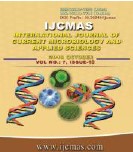


 National Academy of Agricultural Sciences (NAAS)
National Academy of Agricultural Sciences (NAAS)

|
PRINT ISSN : 2319-7692
Online ISSN : 2319-7706 Issues : 12 per year Publisher : Excellent Publishers Email : editorijcmas@gmail.com / submit@ijcmas.com Editor-in-chief: Dr.M.Prakash Index Copernicus ICV 2018: 95.39 NAAS RATING 2020: 5.38 |
A study was carried out to assess the impact of replacement of fish meal by fish silage based blended protein source in Thai-pangas (Pangasianodon hypophthalamus) diet. Five isonitrogenous experimental diets with 35% crude protein level were formulated by replacing fish meal at blended protein source consisting of one third each of fish silage, groundnut oil cake and soya bean meal The growth performance of P. hypophthalmus after feeding with different experimental diets was significantly different. After 90 days of feeding trial the experimental diet with 75% of the fish meal content significantly) higher growth rate of 391.64% than all other experimental diets. The, experimental diet containing 0 % fish meal and 100 % blended protein source showed significantly lower growth rate. The food conversion ratio (FCR) of the experimental diet T₃ was also significantly better than all other diets. The better growth performance of experimental this T₃ might be due to the better availability of digestible protein due to the enzymatic action during the process of silage preparation. After considering all the factors analyzed in the study it may be concluded that the cost effective diet for Thai pangus (P. hypophthalmus) may be formulated by replacing 75 % of the fish meal with blended protein source for better performance in terms of growth of the fish.
 |
 |
 |
 |
 |